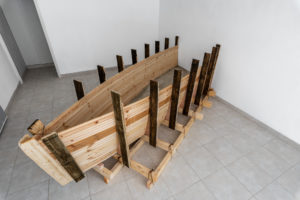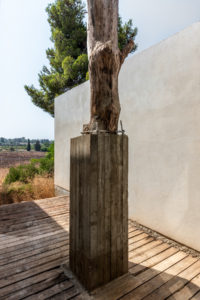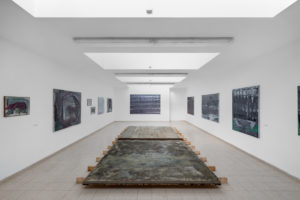Saher Miari: Horizon – September 2020
Wrought in Their Work
Horizon, Saher Miari’s solo exhibition, deals with migration, wandering, and home. His subjects and the materials he uses – concrete, iron and wood – are borrowed from the construction world. Early in their career as artists, both Miari and Kupferman worked in construction, which affected the contents of their artwork as well as its formal characteristics, such as the horizontal lines – “the molder’s alphabet”, as Kupferman put it.
Kupferman’s exhibition space, which hosts another artist for the first time, is now home to “Raft”. A wooden formwork structure supporting two concrete surfaces: one is planed, whereas the other betrays the scars of the planks that supported its molding. Together, they represent two major elements in house construction: floor and wall. “For me”, said Kupferman about the time when he immigrated to Israel, “building a home was more important than even painting”.2 The soil marking between the concrete slabs echoes the zero level – an architectural marking of the “structure”’s location with reference to sea level or the horizon. The soil itself is taken from the fields around the gallery, alluding to the time when the inhabitants of Kafr Makr and the inhabitants of Kibbutz Lohamei HaGeta’ot cultivated the local fields together
The two meanings of “raft” – a foundation for a structure laid over unstable ground and a rudimentary floating surface sometimes used for survival at sea – charge this piece with the tension between resilience and vulnerability, between a settled and nomadic existence, also expressed in the essential nature of the materials – concrete versus wood.
In a broader historical context, we can read Miari’s “Raft” through the iconic “The Raft of the Medusa” by 19th-century painter Théodore Géricault, powerfully symbolic in the Western mind of social wrongs, including the abandonment of refugees, racism, inequality and sheer cruelty.
In the entrance hall, we find a boat made of wooden slabs, with concrete at the bottom, swung among scaffolds that atrophy its function. This work, “Boat No. 5 – Uprooting”, refers to a fishing boat used by Miari’s relatives in Acre until their uprooting to his birthplace and current residence in Kafr Makr in the 1970s. The artist’s disruptive action bemoans a life of refugeehood and migration, and seeks an anchor of a home.
The video piece “With One of His Hands Wrought in the Work” is replaced for the duration of the exhibition with another, which serves as a kind of sequel to that piece. In this work, no workers are seen, but only the functionality of their labor – building a bomb shelter. Miari laments the transparence of Arab workers in Israeli society, and seeks to change that situation. The title is an excerpt from a Biblical verse: “with one of his hands wrought in the work, and with the other hand held a weapon” (Nehemiah 4: 17, KJV). This means that the laborer is busy not only with construction, but also in protecting himself. The choice of omitting the second part of the verse expresses the laborers’ difficulty in defending themselves.
In the piece currently presented, Miari documents himself constructing the current exhibition. This time, he is the “laborer” who produces elements of a “house” that will never serve as such. Displacing the discourse from the construction site to the gallery space raises questions about Miari’s identity and status as artist in local society.
Miari also handles the old pine tree located outside the gallery and seen through its window as it overlooks the entire environment. In “Adaptation”, he “bandages” the tree’s tottering trunk, enabling it to remain rooted in its familiar surrounding. This action can be interpreted as conveying the artist’s yearning for a compassionate, stable society that is rooted in the place, with all its complex contexts, allowing its individuals to be.
Kupferman’s painterly ethos, “a painter is engaged in craft”,3 leads us to Miari, who considers himself a “builder-artist” or “an art worker in the guise of a ‘construction worker’”4 The experience of the two as workers is embedded in their artwork by way of absolute necessity
Tal Bechler
1 Conversation with Yuval Danieli (December 1997), Israel Labor Movement website (Hebrew).
2 Quoted in Yona Fischer (ed.), Moshe Kupferman, Works from 1962 to 2000. Israel Museum, 2002, p. 64 (Hebrew)
3 ibid, p. 65.
4 Miari in a press interview with Karni Am Ed, Hakibbutz 5, 2012 (Hebrew).



